Mastering Beauty Ecommerce to Transform Your Customer Relationships
Trends, Strategies, and Examples
Sep 17, 2024 | 15 minute read
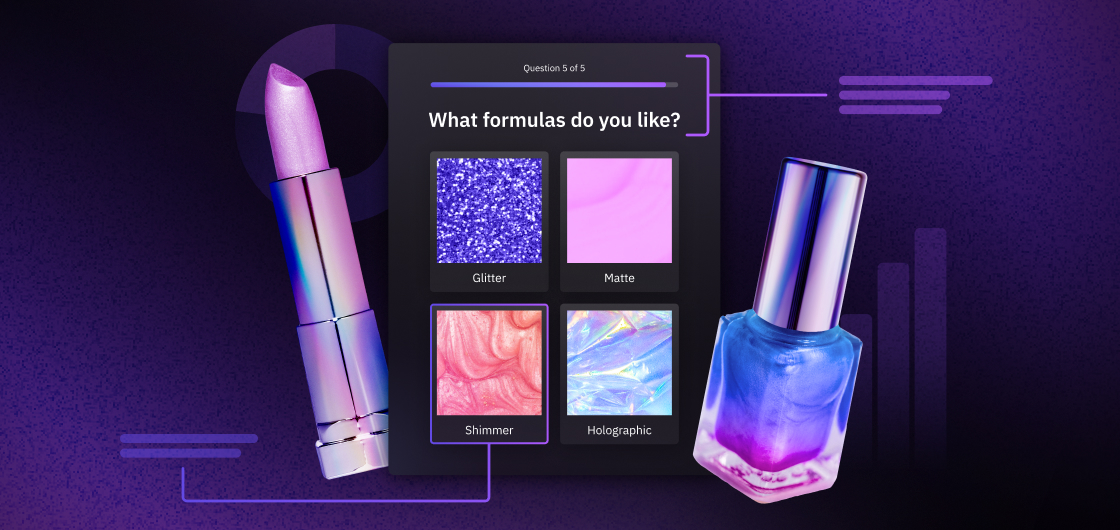
Megan Wenzl
Content Marketing Manager
The beauty industry has changed significantly, coming a long way from in-store-only shopping. In today’s highly competitive ecommerce landscape, marked by high consumer expectations and the widespread adoption of sales channels, brands strive to craft innovative strategies to attract customers and deepen customer relationships.
Consumers shopping for beauty products spend more money through ecommerce than any other retail channel. These customers look for a seamless shopping experience, personalized product recommendations, and engaging content that resonates with their preferences and values.
Navigating the modern consumer environment requires an understanding of the ever-changing trends shaping the beauty industry. Most importantly, these trends highlight the need for brands to know their customers well to build long-term relationships that drive sustainable success.
Get the secrets behind Beauty of Joseon's 284x ROI
Trends and Strategies for Beauty Brands
Here are the top beauty trends and strategies to stand out and win among the competition to succeed now and in the future.
Leveraging Reviews as Social Proof
While reviews are table stakes for all brands, there’s more you can do to maximize your reviews program. Especially during a time when customers question whether or not a brand is credible (and even real), generate and display high-quality reviews throughout the customer journey to stand out in the beauty space.
How do you ensure a successful reviews strategy? The key is to use a reviews program that makes it easy to generate high quantities of high-quality reviews, while maximizing the opportunity to showcase social proof across your entire website. High-quality reviews show descriptive, rich content that may include a photo or video of the customer using your product, with detailed attributes.
Here’s how to create a winning reviews program:
Send Review Request at the Right Time
Generating large quantities of high-quality reviews is one thing, but adding a personalized experience in asking for reviews is just as important. How do you add the personalized touch? Timing.
For beauty brands that sell products that take specific amounts of time to see results, wait to ask customers for reviews until after customers experience results from the product.
If you sell hair or skin care products, for example, it can take weeks or months for customers to see real results. Therefore, you don’t want to send those requests right after a purchase. Instead, to personalize the experience and time the request at peak engagement, wait to send the review request after the customer has used the product for weeks or months.
Showcase Reviews Across your Site
When customers land on your site, they look for reasons to trust your brand and be confident in purchasing your products. This is why social proof — the concept in ecommerce marketing that when people shop they look for reviews from other customers to make purchase decisions — should be prominently displayed throughout your store’s site.
With a review management platform like Okendo Reviews, you can use a review carousel to showcase the highest-rated and most recent reviews. Display review carousels to your product and collections pages, and even your homepage.
In addition, be sure to showcase photos and videos to your pages in the form of media galleries. This user-generated content (UGC) is a cost-effective way to generate high-quality content, while instilling trust in shoppers to purchase from your beauty brand.
Social Proof from Reviews in Social Media and Email Campaigns
To boost marketing campaign success, implement social proof from customers in your social media and email campaigns. You can integrate UGC, star ratings, and reviews to motivate customers to purchase. By putting these elements at the center of your campaigns, you are instilling trust and confidence in customers.
A great example of this is Luna Bronze’s marketing email campaigns. The brand recently sent an email showcasing 1-star reviews that were very positive about the brand. The email reads, “Our Best One Star Reviews. I guess we’ll take these as 5-stars.” The CTA then leads to Luna Bronze’s reviews landing page with all of the reviews they have collected in one page.
Beauty Brand Attributes
To simultaneously capture insights while also displaying features and characteristics of customers, be sure to use attributes in your reviews. Customer attributes are data points that give your brand more information about an individual customer. Customer attributes include hair length, hair color, eye color, and skin type and tone.
Attributes are one component of high-quality reviews that help instill trust and confidence in shoppers, while also understanding your current customers to personalize their experiences.
Product attributes are also important for feedback about your products and to further increase the quality of the review. For hair products, for example, you can ask about the product’s results, conditioning, and how long it lasts. You can also ask customers to add product standouts to reviews. The options include if the hair product conditions well, softens hair, and adds shine.
For a list of attributes and how they work in Okendo, read more on beauty attributes here.
Learn more about Okendo ReviewsEducated Shopping Experiences with AI
Today’s consumers expect engaging and personalized shopping experiences. Research by Okendo reveals two key factors for exceeding these expectations:
- Quizzes or surveys to get to know them better (58%)
- Custom product recommendations (42%)
A highly engaging quiz fulfills these expectations by offering personalized product recommendations and making customers feel like your brand understands and values them – all while collecting data to personalize your marketing campaigns.
Product recommendation quizzes educate shoppers about your products as those products relate to their lifestyle and needs. This ecommerce quiz personalizes customers’ shopping experience, boosting conversions and sales.
AI and Quizzes
With AI, you can easily create an educated shopping experience. Using a quiz AI builder to create a quiz, such as Okendo Quizzes’ Generative AI, saves you time from building a quiz yourself. Instead, you can focus on how the quiz looks, or spend more time personalizing and refining your campaigns. Another benefit to AI? You can get up and running faster, without getting stuck on questions and relevant product recommendations.
Another important reason to implement a quiz with AI is to boost success during Black Friday Cyber Monday (BFCM). Holiday shopping can often be a daunting task for customers, particularly when they are searching for the ideal gift. A quiz can simplify this process by acting as a gift finder. Shoppers can answer questions like, “What is their style?” and specify if this gift is for a friend, family member, or colleague. This approach simplifies holiday shopping, turning it into a seamless and enjoyable experience.
Here are more examples of questions to ask customers with a gift finder quiz:
- “What type of product are you looking for?”
- “What is this person’s main skin concern?”
- “What’s this person’s favorite scent?”
Loyalty Programs
According to recent loyalty program research from Okendo, 77% of customers say they are more likely to remain loyal to a brand long-term if it offers a compelling loyalty program.
And especially for beauty brands, loyalty programs build stronger customer relationships. The best loyalty programs increase lifetime value and boost revenue, with 72% of customers saying they purchase from a brand more often if they are part of the brand’s loyalty program.
Loyalty programs also help beauty brands build a community of Superfans, your most highly engaged customers. These customers reduce acquisition costs and have high lifetime value. These valuable customers engage in activities that help bring in new customers, like making a referral or leaving a positive review.
While loyalty programs are a long-standing marketing strategy, the key lies in designing a program that resonates deeply with your unique customer base. By creating a unique loyalty program that speaks directly to your customers and who they are, while staying consistent to your brand, you establish a profound connection that instills a sense of belonging to a larger community.
Build your dream loyalty programA Strategy to Build Relationships with Superfans
Loyalty programs provide a strategy for your brand to build relationships with your Superfans, ensuring that these devoted customers receive the attention and thank you they deserve. Otherwise, this segment of customers often becomes an afterthought.
For example, Luna Bronze’s loyalty program makes it efficient for them to connect with their Superfans and build relationships with them. They do this by sending their loyal customers email flows.
A loyalty program gives you the power to connect with your customers about the program, such as sending customers how many points they have or their loyalty VIP tier status level. This allows for genuine connection, as opposed to general marketing emails.
Designing a loyalty program uniquely for your Superfans includes implementing a tier-based program, creatively naming your tiers and rewards, and providing customers with the flexibility to earn points beyond purchases.
Community Building
In today’s competitive environment, customers seek out a sense of community to genuinely connect with a brand. Creating and connecting with customers within your brand community makes them feel like they are part of something bigger than simply purchasing a product.
How to Personalize Experiences to Create a Community
The best way to personalize customer experiences is with the strategies already discussed — reviews and quizzes. Another important piece to this is surveys.
Reviews build a community. Customers can leave detailed reviews with attributes, such as hair type and age range. This makes it easier for customers to get advice from other customers through reviews as to whether a product is right for them.
Responding to reviews also helps build community by showing you are listening to what reviewers are saying, and making it known to prospective customers that you listen to your customers.
With Surveys, you can make customers feel part of a community by actively listening to them — their opinions, personalized details, and feedback.
NPS surveys, for example, are an essential survey to understand how likely a customer would recommend your brand to others. This survey is a gauge for loyalty and identifies loyal Superfans. In turn, this survey helps you identify detractors, so you can create strategies to turn them into loyal customers.
Information you collect in zero-party data from surveys, reviews, and quizzes also helps personalize marketing campaigns and experiences.
For example, a beauty brand that sells hair products and knows a segment of customers is most concerned about graying hair, you can send this segment personalized content on products and remedies to reduce graying hair.
Marketing Attribution Surveys
As a marketer for a beauty brand, you spend tons of time and energy creating engaging campaigns.
That’s why knowing exactly where customers are coming from to your store helps maximize your campaigns’ effectiveness. The best way to understand your most successful marketing channels is to hear it directly from customers in a marketing attribution survey.
For your beauty brand, How Did You Hear About Us? (HDYHAU) surveys tell you exactly where customers are coming from, like TikTok, an important channel for Beauty Brands. You can also discover if a customer learned about your brand from an influencer to understand if that influencer’s audience is where your customer base is.
Because the majority of beauty sales still take place in person in places like grocery stores and specialty retail stores, a HDYHAU survey informs you how many customers learn about your products in retail stores. You can create strategies based on this knowledge to drive more sales. This could include incentivizing customers who drop off onsite to try your product in a retail store first.
Examples of The Fastest-Growing Beauty Brands Implementing Marketing Strategies
Let’s dive into examples of the fastest-growing brands that are experiencing faster and more efficient growth by implementing these above trends and strategies into their overall marketing strategy.
1. Beauty of Joseon – Quizzes
With its Skin Quiz, Beauty of Joseon offers personalized skincare recommendations based on customers’ unique skincare needs.
Beauty of Joseon successfully integrates quizzes into their overall marketing strategy with Okendo Quizzes. The results prove it, with an 87% completion rate for their Skin Quiz. With quizzes, the brand can expand more sales to skincare products beyond sunscreen because the brand’s products are most beneficial when used together.
Hyona Cho, Brand Communications Manager at Beauty of Joseon says, “The Skin Quiz really streamlines the customer experience by recommending the full regimen skincare routine. By providing products to satisfy each step in the process, it benefits not only the customer but also our customer service team, resulting in an impressive 90% reduction in skincare product recommendation inquiries.”
The brand also saw an 8% quiz conversion rate, which is double the entire store’s conversion rate. Check out their Skin Quiz here.
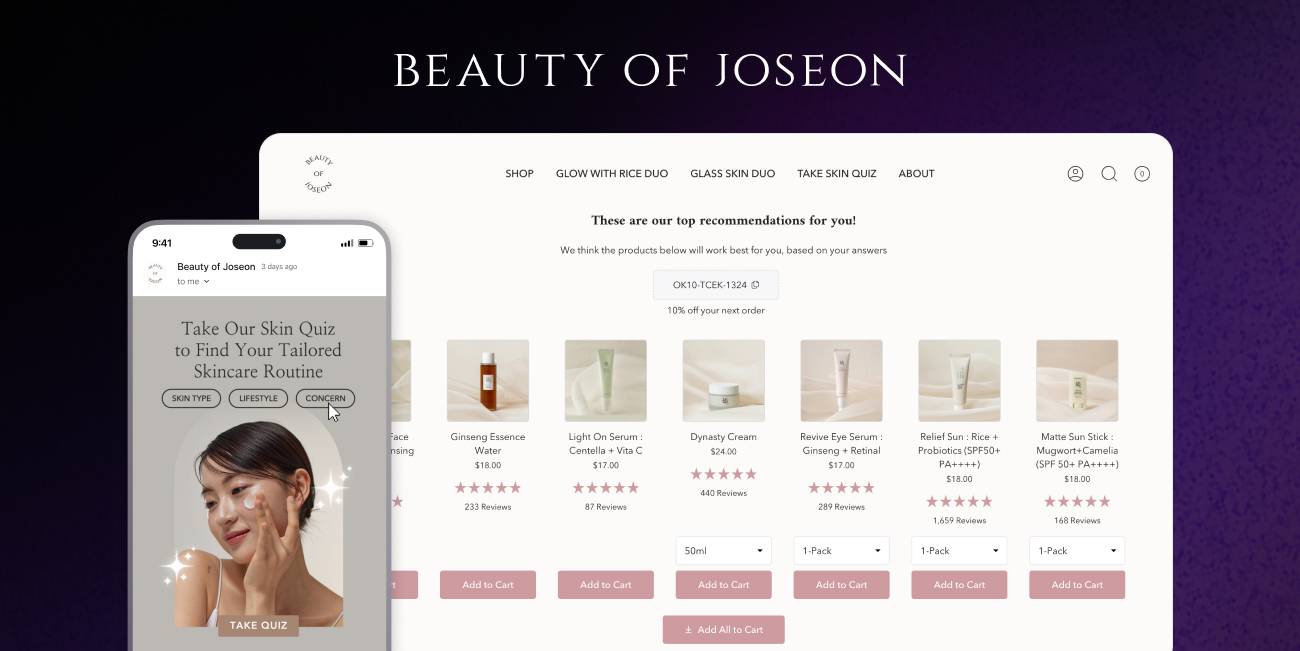
2. The Collagen Co. – Referrals
The Collagen Co. is a beauty brand on a mission to help customers feel more confident, radiant, and unstoppable through Collagen. To combat rising acquisition costs, they use referrals to acquire customers at low-cost. They seamlessly send requests to their most loyal customers, building a community of Superfans.
They launched their program with Okendo Referrals in just 20 minutes. A setup time that meant they were up and running their program fast. The brand also saw an impact of a 9.7% conversion rate.
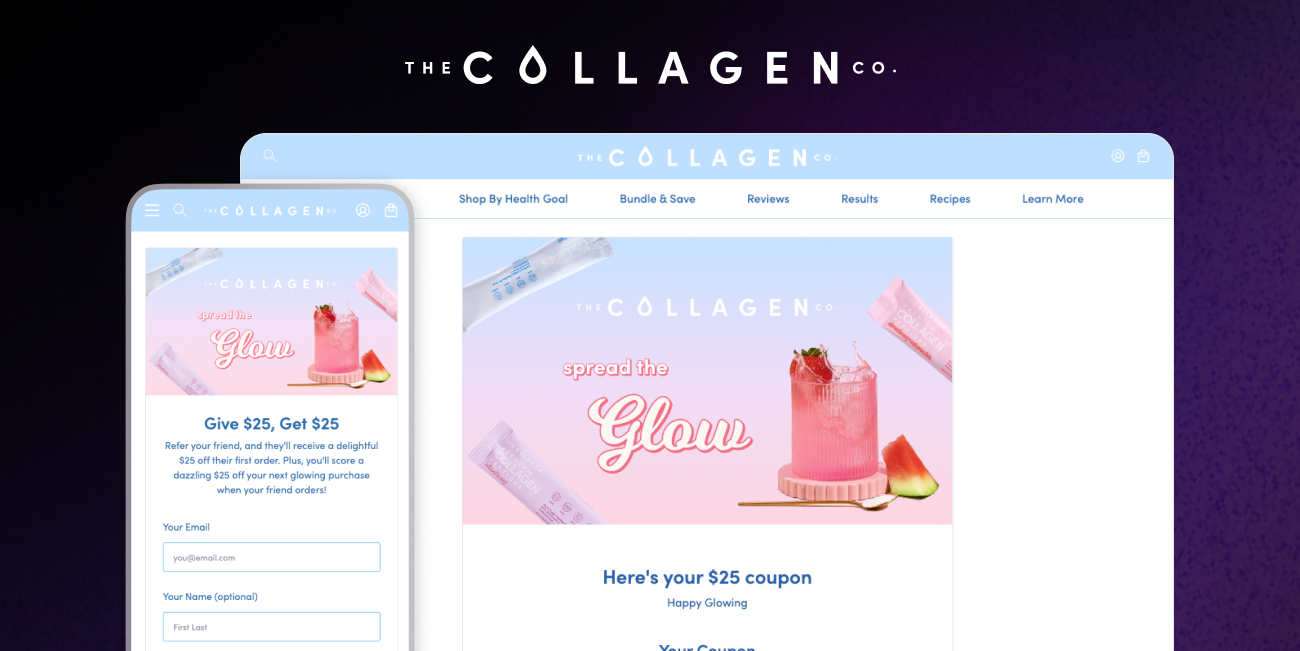
3. Luna Bronze – Loyalty and Quizzes
Luna Bronze excels in using quizzes and implementing a loyalty program. The brand attributes 10% of revenue to Okendo Quizzes.
Maddy Balderson, Director & Co-Founder of Luna Bronze says, “We tried some different quiz apps that were really clunky and hard to build. Okendo Quizzes was easy to implement, and customers can now seamlessly find the right product for them.”
The brand prominently features their quiz on their homepage, site navigation, and in email flows. The quiz Luna Bronze created guides customers to the right tanner based on the customer’s needs. The team also asks if the purchase is for the customer making the purchase or if it’s a gift. Luna Bronze’s quiz asks the customer skin-related questions tailored to the customer or the gift recipient, such as the desired tan area and skin tone to ensure that recommendations are personalized.
Luna Bronze expanded its strategy with its loyalty program. The team at Luna Bronze now has a specified strategy to leverage their Superfans — or VIBs (Very Important Bronzers).
Maddy Balderson, Director & Co-Founder of Luna Bronze says, “The loyalty program helps us make it much more efficient [to connect with our VIBs, or Very Important Bronzers]. Now, we have a strategy to start fostering relationships with those VIBs.”
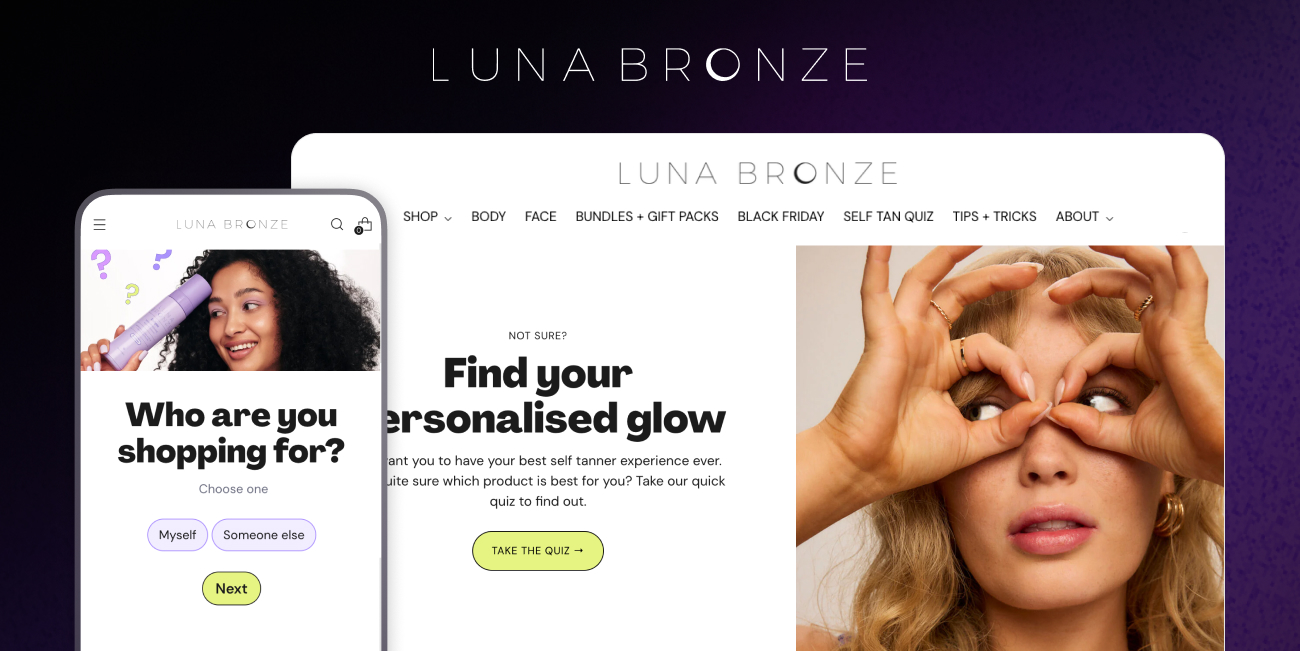
4. Vegamour – Reviews
An example of a beauty brand that asks customers for reviews at the right time is Vegamour. Vegamour’s hair products take differing amounts of time for customers to see the results, so timing is crucial for engagement.
It takes three months to see the results of Vegamour’s gray hair products. Because of this, Vegamour sets specific triggers in Okendo Reviews to send review requests after the customer uses the product for three months.
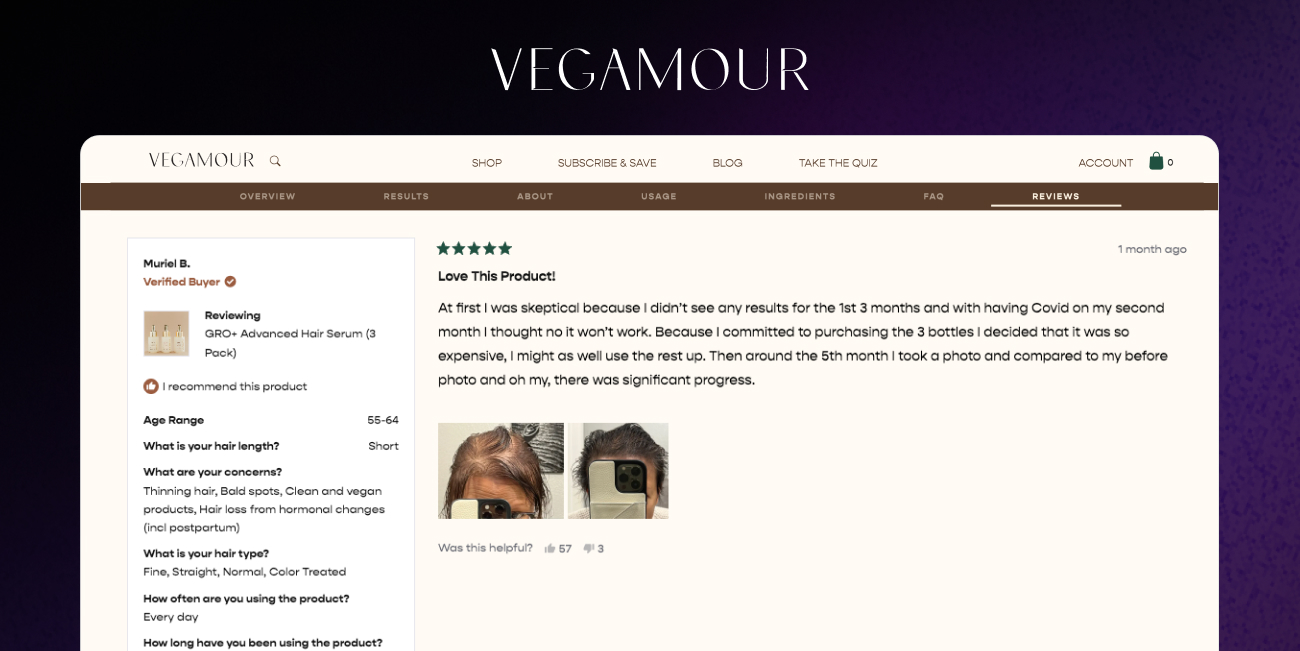
5. Lashify – Reviews
Lashify, a beauty brand with an award-winning DIY Lash extension system, prominently displays reviews on its PDPs. They call their reviews widget the “VIBE METER” with intensity level and vibe ranges of the product. Their widget engages shoppers right away, encouraging them to keep scrolling down the page to read the detailed reviews.
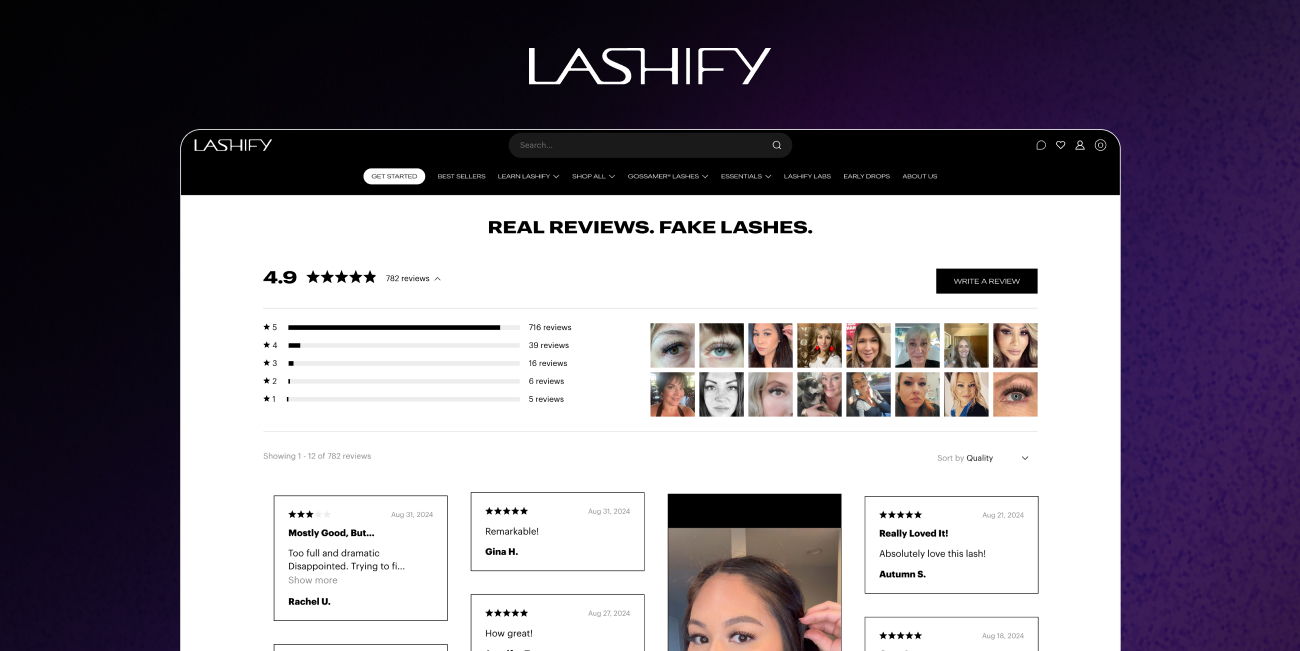
6. ILIA Beauty – Reviews
ILIA Beauty, a brand with a mission to protect and revive customers’ skin, does a great job of displaying customer attributes. They use a review carousel to showcase powerful UGC.
The attributes they display in their reviews are skin type, skin tone, undertone, and age range.
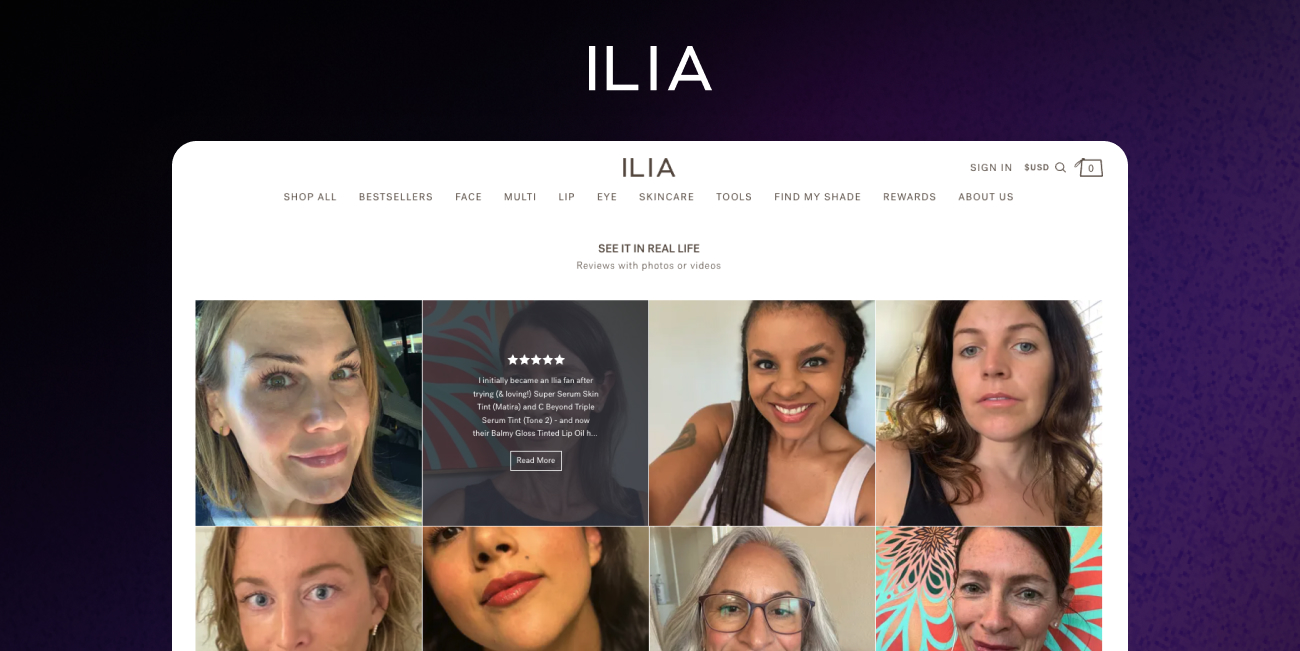
7. Rhode – Reviews
Speaking of attributes, Rhode is another example of a beauty brand that asks for and displays attributes on their PDPs. Customer attributes are age range and skin type. Product attributes show favorite features about the product and how nourishing the product is.
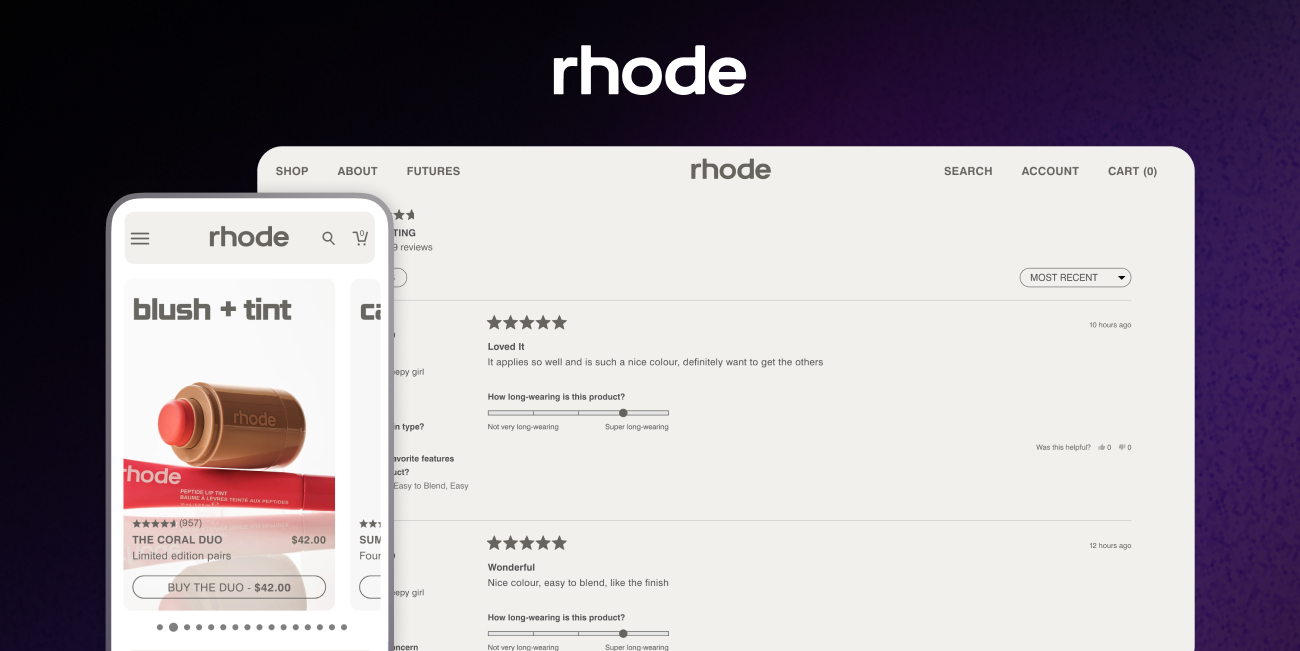
8. Krave Beauty – Reviews
Krave Beauty displays a media gallery and star rating in its reviews widgets on PDPs to showcase social proof in the places that matter most. The brand also uses attributes – with skin concerns and skin type as customer attributes.
They ask, “What did you like about this product?” as a product attribute.
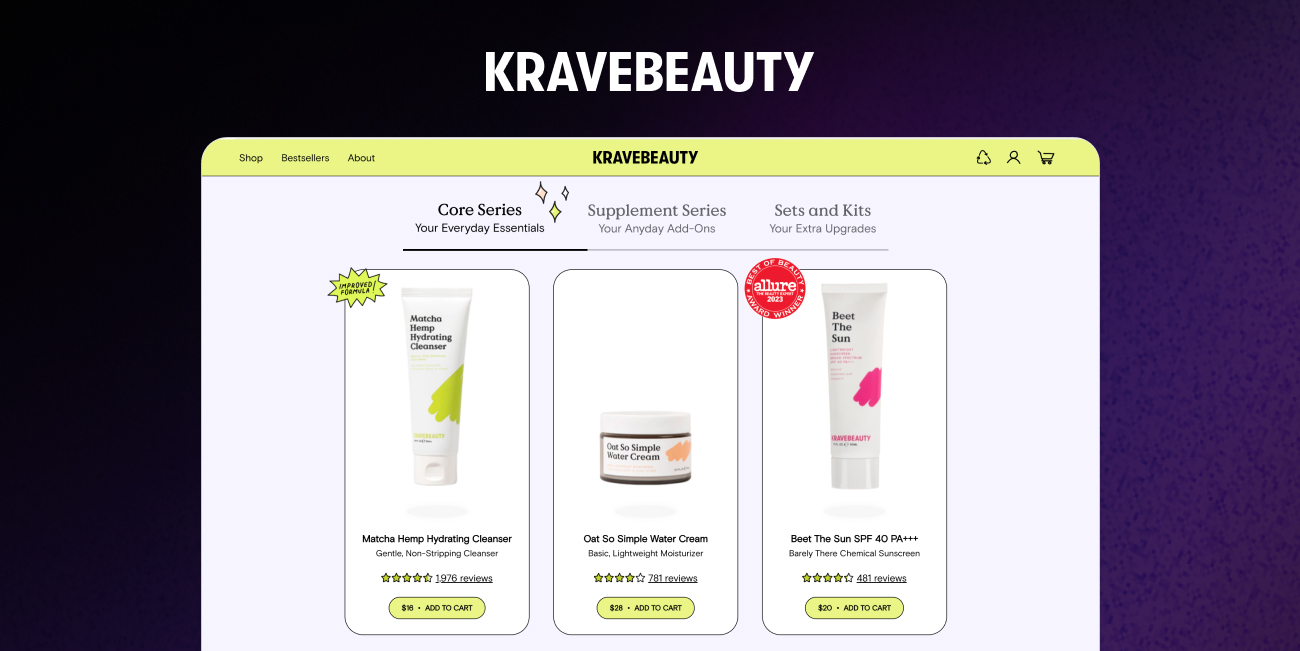
Conclusion
The beauty ecommerce landscape presents both challenges and opportunities for brands striving to differentiate themselves and build lasting relationships with customers.
Implementing a robust reviews program gives brands the opportunity to leverage customer feedback to enhance product quality and personalize experiences, while simultaneously fostering trust and confidence among potential buyers.
Alongside this, loyalty programs effectively incentivize repeat purchases and reward consumer loyalty, driving higher engagement and retention rates.
In addition, guided shopping experiences with quizzes and AI can significantly improve the shopping journey by providing personalized recommendations that cater to individual preferences, ultimately leading to increased sales. Finally, nurturing a customer community creates a dynamic space for users to interact, share insights, and feel connected to the brand, further deepening loyalty.
By integrating these strategies, beauty ecommerce brands can create a strategic approach that not only exceeds consumer expectations but also transforms customer relationships to gain a competitive edge in this vibrant and ever-evolving industry.
Ready to learn more?
